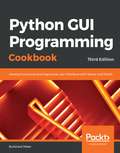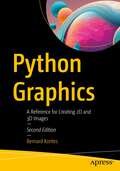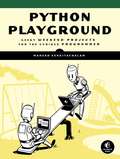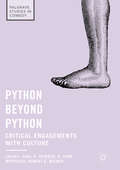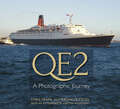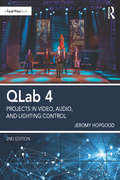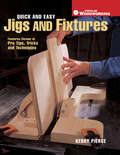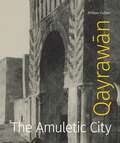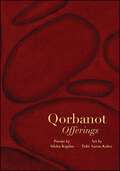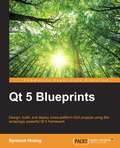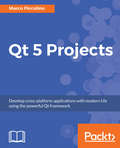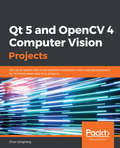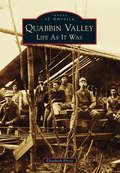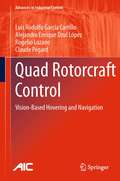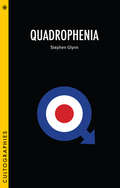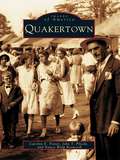- Table View
- List View
Python GUI Programming Cookbook: Develop functional and responsive user interfaces with tkinter and PyQt5, 3rd Edition
by Burkhard MeierOver 90 recipes to help you develop widgets, forms, layouts, charts, and much more using the latest features of Python 3 Key Features Use object-oriented programming to develop impressive GUIs in Python Create interesting charts to visually represent data using Matplotlib Develop GUIs with the latest versions of tkinter, PyQt5, and wxPython frameworks Book Description Python is a multi-domain, interpreted programming language that is easy to learn and implement. With its wide support for frameworks to develop GUIs, you can build interactive and beautiful GUI-based applications easily using Python. This third edition of Python GUI Programming Cookbook follows a task-based approach to help you create effective GUIs with the smallest amount of code. Every recipe in this book builds upon the last to create an entire, real-life GUI application. These recipes also help you solve problems that you might encounter while developing GUIs. This book mainly focuses on using Python's built-in tkinter GUI framework. You'll learn how to create GUIs in Python using simple programming styles and object-oriented programming (OOP). As you add more widgets and expand your GUI, you will learn how to connect to networks, databases, and graphical libraries that greatly enhance the functionality of your GUI. You'll also learn how to use threading to ensure that your GUI doesn't become unresponsive. Toward the end, you'll learn about the versatile PyQt GUI framework, which comes along with its own visual editor that allows you to design GUIs using drag and drop features. By the end of the book, you'll be an expert in designing Python GUIs and be able to develop a variety of GUI applications with ease. What you will learn Create amazing GUIs with Python's built-in tkinter module Customize GUIs using layout managers to arrange GUI widgets Advance from the typical waterfall coding style to an OOP style using Python Develop beautiful charts using the free Matplotlib Python module Use threading in a networked environment to make GUIs responsive Discover ways to connect GUIs to a MySQL database Understand how unit tests can be created and internationalize GUI Delve into the world of GUI creation using PyQt5 Who this book is for If you're a programmer or developer looking to enhance your Python skills by writing powerful GUI applications, this book is for you. Familiarity with the Python programming language is necessary to get the most out of the book.
Python Graphics: A Reference for Creating 2D and 3D Images
by B. J. KoritesUse Python's built-in features to create innovative graphics for data visualization and technical illustrations. This book goes beyond simple commands and libraries to explain how to not only display but also rotate, shade, and edit graphics for any purpose. Starting with the essential Python functions to set up a plotting space and produce 2 and 3-dimensional objects, you'll learn how to construct more complex objects, translate and rotate them, remove hidden lines, introduce shading to add realism, and project images to visualize any dataset. The final chapter includes several worked applications in science and engineering including planetary models, which you can adapt for your own use.Written for developers who want to harness Python's capabilities to fine-tune their images, Python Graphics covers the different commands for plotting dots, lines, arrows, or arcs, creating custom plotting grids, correcting distortions, adding text and labels to illustrations, manipulating arcs and circles, specify and use colors, and more. Armed with these techniques and core math skills, you'll be ready to create and customize detailed technical illustrations or data visualizations. What You'll LearnUse Python′s built-in commands for plotting, removing distortions, and rotating objectsCreate and edit 2D and 3D objectsDevelop illustrations for scientific and engineering applicationsWho This Book Is ForPython developers looking for tips on how to create illustrations and visualizations, as well as scientists, engineers, or students using Python. It assumes familiarity with vectors, matrices, geometry and trigonometry.
Python Graphics: A Reference for Creating 2D and 3D Images
by Bernard KoritesThis book shows how to use Python’s built-in graphics primitives - points, lines, and arrows – to create complex graphics for the visualization of two- and three-dimensional objects, data sets, and technical illustrations. This updated edition provides more detailed explanations where required, especially regarding Python code, and explores scientific applications to topics of contemporary importance. You’ll learn how to create any 2D or 3D object or illustration, as well as how to display images, use color, translate, rotate, shade, add shadows that are cast on other objects, remove hidden lines, plot 2D and 3D data, fit lines and curves to data sets, display points of intersection between 2D and 3D objects, and create digital art. Demonstrations are included which illustrate graphics programming techniques by example, the best way to learn a language. Also brand new to this edition are demonstrations on how to visualize electron probability clouds around a nucleus, climate change, ecological diversity, population dynamics, and resource management. Python source code, including detailed explanations, is included for all applications, making the book more accessible to novice Python programmers. After completing this book, you will be able to create compelling graphic images without being limited to functions available in existing Python libraries. What You Will Learn Create 2D and 3D graphic imagesAdd text and symbols to imagesShade 3D objectsDisplay cast shadowsUse color for maximum effectView 2D and 3D data setsFit lines and curves to data sets Who This Book Is For Python developers, scientists, engineers, and students who use Python to produce technical illustrations and display and analyze data sets. Assumes familiarity with vectors, matrices, geometry and trigonometry.
Python Playground, 2nd Edition: Geeky Projects for the Curious Programmer
by Mahesh VenkitachalamPut the fun back in Python programming and build your skills as you create 3D simulations and graphics, speech-recognition machine-learning systems, IoT devices, and more.The fully updated 2nd edition is here, now with 5 brand-new projects!Harness the power of Python as you turn code into tangible creations with Python Playground, a collection of 15 inventive projects that will expand your programming horizons, spark your curiosity, and elevate your coding skills.Go beyond the basics as you write programs to generate art and music, simulate real-world phenomena, and interact with hardware, all through the use of Python and common libraries such as numpy, matplotlib, and Pillow.As you work through the book&’s projects, you will:Craft intricate Spirograph-like designs with parametric equations and the turtle moduleGenerate music by synthesizing plucked string soundsTransform everyday images into ASCII art, photomosaics, and eye-popping autostereogramsDesign engaging cellular automata and flocking simulationsExplore the realm of 3D graphics, from basic shape rendering to visualizing MRI scan dataBuild a Raspberry Pi–powered laser show that dances along with musicNew to this edition: We&’ve expanded your playground with five new projects: you&’ll draw fractals, bring Conway&’s Game of Life into 3D space, and use a Raspberry Pi and Python to create a musical instrument, an IoT garden monitor, and even a machine learning–driven speech recognition system.Whether you&’re a seasoned professional or just getting started, you&’ll find Python Playground to be a great way to learn, experiment with, and master this versatile programming language.Covers Python 3.x
Python Playground: Geeky Projects for the Curious Programmer
by Mahesh VenkitachalamPython is a powerful programming language that’s easy to learn and fun to play with. But once you’ve gotten a handle on the basics, what do you do next?Python Playground is a collection of imaginative programming projects that will inspire you to use Python to make art and music, build simulations of real-world phenomena, and interact with hardware like the Arduino and Raspberry Pi. You’ll learn to use common Python tools and libraries like numpy, matplotlib, and pygame to do things like:–Generate Spirograph-like patterns using parametric equations and the turtle module–Create music on your computer by simulating frequency overtones–Translate graphical images into ASCII art–Write an autostereogram program that produces 3D images hidden beneath random patterns–Make realistic animations with OpenGL shaders by exploring particle systems, transparency, and billboarding techniques–Construct 3D visualizations using data from CT and MRI scans–Build a laser show that responds to music by hooking up your computer to an ArduinoProgramming shouldn’t be a chore. Have some solid, geeky fun with Python Playground.The projects in this book are compatible with both Python 2 and 3.
Python beyond Python
by Paul N. Reinsch B. Lynn Whitfield Robert G. WeinerThis collection of original, interdisciplinary essays addresses the work of Monty Python members beyond the comedy show, films, and live performances. These men are prolific creators in a variety of artistic realms beyond the confines of the comedy troupe. Their work as individuals, before and after coming together as Monty Python, demonstrates a restless curiosity about culture that embraces absurdity but seldom becomes cynical. Python members collectively and individually create unique approaches to theatre, film, video games, comic books, business training videos and more. Python Beyond Python increases our understanding of this often neglected work and the meanings of Monty Python.
Pájaros de cuidado: Reflexiones y divagaciones sobre aves, personas, ciencia y cultura
by José Luis Cortés Montesinos¿Abejarucos y Fórmula 1? ¿Buitres o pardillos? ¿Ciencia o leyenda? Pájaros y algo más. ¿Alguna vez te han llamado cabeza de chorlito o pardillo, águila, cernícalo, buitre o chotacabras? ¿Tienes la cabeza a pájaros o eres un pájaro de cuidado? Todos los pájaros lo son, de cuidado. Debemos cuidarlos, porque, además de impregnar nuestra cultura, su comportamiento, sus plumajes y sus cantos son un espectáculo gratificante. Cada capítulo de este libro da fe de ello, pues Pájaros de cuidado es una serie de vivencias y reflexiones en torno a las aves, los lugares que habitan y algunas personas vinculadas a ellas. Reflexiones basadas en la biología evolutiva y la ecología, en leyendas y en el origen de sus nombres, con un tono desenfadado y a veces irónico, pero siempre inspirado por el disfrute del contacto con la naturaleza y la importancia de la ciencia para su comprensión.
QE2: A Photographic Journey (A Photographic Journey)
by Chris Frame Rachelle Cross Ian McNaughtSince her maiden voyage in 1969 the QE2 has delighted the thousands of guests who have been lucky enough to spend time aboard this world-famous ship and fascinated many more. She is the most famous ocean liner of our time and has achieved iconic status worldwide. Now, after four decades in the limelight, QE2 will be retiring in November 2008 to begin a new life as a hotel in Dubai. QE2: A Photographic Journey marks the end of an era by taking the reader on a voyage of appreciation of the most loved ocean liner in the world. Readers can stroll the decks, visit the various bars and lounges, take high tea in the Queen's Room and retire to their cabin without leaving their armchair! Each public room is detailed with colour photographs and historical commentary, including quirky and amusing anecdotes and snippets of information about the ship and some of the many characters who have sailed aboard her. Written by two enthusiastic fans and frequent QE2 travellers, this book is beautifully illustrated with over two hundred colour photographs, and complemented by new information from Commodore R.W. Warwick, former master of QE2 and the son of the first captain. This affectionate record provides the most fitting of souvenirs as the QE2 sails into history.
QLab 3 Show Control
by Jeromy HopgoodUsed from Broadway to Britain's West End, QLab software is the tool of choice for many of the world's most prominent sound, projection, and integrated media designers. QLab 3 Show Control: Projects for Live Performances & Installations is a project-based book on QLab software covering sound, video, and show control. With information on both sound and video system basics and the more advanced functions of QLab such as MIDI show control, new OSC capabilities, networking, video effects, and microphone integration, each chapter's specific projects will allow you to learn the software's capabilities at your own pace. Tutorials and additional resources are featured at www.focalpress.com/cw/hopgood.
QLab 4: Projects in Video, Audio, and Lighting Control
by Jeromy HopgoodUsed from Broadway to Britain's West End, QLab software is the tool of choice for many of the world's most prominent sound, projection, and integrated media designers. QLab 4: Projects in Video, Audio, and Lighting Control is a project-based book on QLab software covering sound, video, lighting, and show control. With information on audio, video, and lighting system basics and the more advanced functions of QLab such as show control, network capabilities, projection mapping, video effects, and cue cart integration, each chapter's specific projects will allow you to learn the software's capabilities at your own pace. In addition to the text, a companion website hosts project files, instructional videos, and more.
QUICK AND EASY Jigs AND Fixtures
by Kerry PierceSimple, Astonishingly Effective Jigs You've Never Seen Anywhere ElseAdd speed, accuracy and ease to almost every operation in your shop with this book of 16 ingenious jigs, clever workshop aids and amazing devices that you simply cannot buy in any store. These jigs are the helping hands that turn a bench-pounding frustrating glue-up into a calm, controlled and confident operation. They're the things that tool manufacturers should have added to all your tools, and they're the time-saving shortcuts you wish you'd thought of. Cut accurate tenons on any curved shape with a one-piece table saw jig. Trick your drill press to bore accurate mortises at any conceivable angle. Sculpt elegant raised-panel doors with the safest and most adjustable jig ever. Turn parts of any length (yes, any length) without ever moving your lathe's tool rest. Secure parts of any shape to your bench with ever-obedient bench dogs and dirt-simple cradles. Draw accurate arcs and circles that are out of range of all commercial compasses.
Qayrawān: The Amuletic City (Refiguring Modernism)
by William GalloisIn the last years of the nineteenth century, the Tunisian city of Qayrawān suddenly found itself covered in murals. Concentrated on and around the city’s Great Mosque, these monumental artworks were only visible for about fifty years, from the 1880s through the 1930s. This book investigates the fascinating history of who created these outdoor paintings and why.Using visual archaeological methods, William Gallois reconstructs the visual history of these works and vividly brings them back to life. He locates pictorial records of the murals from the backdrops of photographs, postcards, and other forms of European ephemera. In Qayrawān, he identifies a form of religious painting that transposed traditional aesthetic forms such as house decoration, embroidery, and tattooing—which lay exclusively within the domains of women—onto the body of a conquered city. Gallois argues that these works were created by women as a form of “emergency art,” intended to offer amuletic protection for the community, and demonstrates how they differ markedly from “classical” Islamic antecedents and modern modes of Arab cultural production in the Middle East and North Africa.Based on extensive archival research, this study is both a record of a unique moment in the history of art and a challenge to rethink the spiritual force and agency of a group of anonymous female artists whose paintings aspired to help save the world at a time of great peril. It will be welcomed by scholars of art history, Islamic studies, Middle East studies, and the history of magic.
Qorbanot: Offerings (SUNY series in Contemporary Jewish Literature and Culture)
by Alisha KaplanA dynamic dialogue of poetry and art that reimagines the ancient, biblical concept of sacrifice.Winner of the 2022 Gerald Lampert Memorial Award presented by the League of Canadian Poets A collaboration between poet Alisha Kaplan and artist Tobi Aaron Kahn, Qorbanot-the Hebrew word for "sacrificial offerings"-explores the concept of sacrifice, offering a new vision of an ancient practice. A dynamic dialogue of text and image, the book is a poetic and visual exegesis on Leviticus, a visceral and psychological exploration of ritual offerings, and a conversation about how notions of sacrifice continue to resonate in the twenty-first century.Both from Holocaust survivor families, Kaplan and Kahn deal extensively with the Holocaust in their work. Here, the modes of poetry and art express the complexity of belief, the reverberations of trauma, and the significance of ritual. In the poems, the speaker, offspring of burnt offerings, searches for meaning in her grandparents' experiences and in the long tradition of Orthodox Judaism in which she was raised. Kahn's paintings on handmade paper, drawn from decades of his career as an artist, have not previously been exhibited or published. They reflect his quest to distill a legacy of trauma and loss into enduring memory.With a foreword by James E. Young and essays by Ezra Cappell, Lori Hope Lefkovitz, and Sasha Pimentel, the book presents new directions for thinking about what sacrifice means in religious, social, and personal contexts, and harkens back to foundational traditions, challenging them in reimagined and artistic ways.
Qt 5 Blueprints
by Symeon HuangIf you are a programmer looking for a truly cross-platform GUI framework to help you save your time by side-stepping the incompatibility between different platforms and building applications using Qt 5 for multiple targets, then this book is most certainly intended for you. It is assumed that you have a basic programming experience of C++ and fundamental knowledge about Qt.
Qt 5 Projects: Develop cross-platform applications with modern UIs using the powerful Qt framework
by Marco Aldo Piccolino BonifortiDesign, build, and deploy powerful applications with amazing user interfaces on embedded, mobile, and desktop platforms Key Features Easily compile, run, and debug your applications from the powerful Qt Creator IDE Future-proof your applications with Qt Test and modern architecture principles Build multi-platform projects that target Android, iOS, Windows, macOS, Linux, and more Book Description Qt is a professional cross-platform application framework used across industries like automotive, medical, infotainment, wearables, and more. In this book you’ll initially create a to-do style app by going via all stages for building a successful project. You'll learn basics of Qt's C++ and QML APIs, test-driven development with Qt Test, application architecture, and UIs with Qt Quick & Quick Controls 2. Next, you’ll help two startups build their products. The first startup, Cute Comics, wants to help independent comic creators with a suite of apps that let them experiment with comic pages, image composition, comic dialogues, and scene descriptions. While developing these apps you’ll deepen your knowledge of Qt Quick's layout systems, and see Qt 3D and Widgets in action. The second startup, Cute Measures, wants to create apps for industrial and agricultural sectors, to make sense of sensor data via a monitoring system. The apps should run seamlessly across devices and operating systems like Android, iOS, Windows, or Mac, and be cost-effective by integrating with existing web technologies. You take the role of lead developer and prototype the monitoring system. In doing so you’ll get to know Qt's Bluetooth and HTTP APIs, as well as the Charts and Web Engine UI modules. These projects will help you gain a holistic view of the Qt framework. What you will learn Learn the basics of modern Qt application development Develop solid and maintainable applications with BDD, TDD, and Qt Test Master the latest UI technologies and know when to use them: Qt Quick, Controls 2, Qt 3D and Charts Build a desktop UI with Widgets and the Designer Translate your user interfaces with QTranslator and Linguist Get familiar with multimedia components to handle visual input and output Explore data manipulation and transfer: the model/view framework, JSON, Bluetooth, and network I/O Take advantage of existing web technologies and UI components with WebEngine Who this book is for This book is for developers who want to successfully build and maintain cross-platform applications with advanced UI and connectivity features. Basic knowledge of C++ is required.
Qt 5 and OpenCV 4 Computer Vision Projects: Get up to speed with cross-platform computer vision app development by building seven practical projects
by Zhuo QingliangCreate image processing, object detection and face recognition apps by leveraging the power of machine learning and deep learning with OpenCV 4 and Qt 5. Key Features: Gain practical insights into code for all projects covered in this book; Understand modern computer vision concepts such as character recognition, image processing and modification; Learn to use a graphics processing unit (GPU) and its parallel processing power for filtering images quickly. Book Description: OpenCV and Qt have proven to be a winning combination for developing cross-platform computer vision applications. By leveraging their power, you can create robust applications with both an intuitive graphical user interface (GUI) and high-performance capabilities. This book will help you learn through a variety of real-world projects on image processing, face and text recognition, object detection, and high-performance computing. You’ll be able to progressively build on your skills by working on projects of increasing complexity.You’ll begin by creating an image viewer application, building a user interface from scratch by adding menus, performing actions based on key-presses, and applying other functions. As you progress, the book will guide you through using OpenCV image processing and modification functions to edit an image with filters and transformation features. In addition to this, you’ll explore the complex motion analysis and facial landmark detection algorithms, which you can use to build security and face detection applications. Finally, you’ll learn to use pretrained deep learning models in OpenCV and GPUs to filter images quickly. By the end of this book, you will have learned how to effectively develop full-fledged computer vision applications with OpenCV and Qt. What you will learn: Create an image viewer with all the basic requirements; Construct an image editor to filter or transform images; Develop a security app to detect movement and secure homes; Build an app to detect facial landmarks and apply masks to faces; Create an app to extract text from scanned documents and photos; Train and use cascade classifiers and DL models for object detection; Build an app to measure the distance between detected objects; Implement high-speed image filters on GPU with Open Graphics Library (OpenGL). Who this book is for: This book is for engineers and developers who are familiar with both Qt and OpenCV frameworks and are capable of creating simple projects using them, but want to build their skills to create professional-level projects using them. Familiarity with the C++ language is a must to follow the example source codes in this book.
Quabbin Valley: Life As It Was (Images of America)
by Elizabeth PeirceQuaben, the Nipmuc Indian word for "many waters," was the name originally given to the area of central Massachusetts that is now known as the Quabbin Valley. The abundance of ponds, lakes, and streams in the region made it an obvious target for those seeking new water sources to supply the escalating population of Boston in the late 19th century. However, the little towns of Dana, Enfield, Greenwich, and Prescott that were established in the area stood in the way. Following an act of the legislature in 1926, these towns were disincorporated, and the 2,500 inhabitants were given modest compensation and ordered to leave. By 1938, the former towns were flooded and stood at the floor of the reservoir, which held the potential of 420 billion gallons of water to be outsourced eastward. Never to be forgotten, the story of the lost towns and their former residents are displayed through artifacts housed at the Swift River Valley Historical Society in North New Salem.
Quad City International Airport (Images of Aviation)
by David T. CoopmanIn 1922, three men were so captivated with flying they leased 30 acres of cow pasture south of Moline to serve as a landing field. Other early aviators and barnstormers began using Franing Field, and it soon became known as Moline Airport. The field hosted the Ford Reliability Tour four times, served as part of the original New York to Dallas airmail route, had passenger service as early as 1927, became one of Illinois's largest Works Progress Administration projects, weathered financial struggles and a battle with neighboring Davenport, Iowa, over which community would possess the area's commercial airport, and has enjoyed constant growth and updates for both airline and general aviation traffic. This collection of historical photographs and images will present the people, planes, events, and development of that former pastureland into today's modern Quad City International Airport, the third largest airport for passenger traffic in the state of Illinois.
Quad Rotorcraft Control
by Rogelio Lozano Claude Pégard Luis Rodolfo García Carrillo Alejandro Enrique Dzul LópezQuad Rotorcraft Control develops original control methods for the navigation and hovering flight of an autonomous mini-quad-rotor robotic helicopter. These methods use an imaging system and a combination of inertial and altitude sensors to localize and guide the movement of the unmanned aerial vehicle relative to its immediate environment. The history, classification and applications of UAVs are introduced, followed by a description of modelling techniques for quad-rotors and the experimental platform itself. A control strategy for the improvement of attitude stabilization in quad-rotors is then proposed and tested in real-time experiments. The strategy, based on the use low-cost components and with experimentally-established robustness, avoids drift in the UAV's angular position by the addition of an internal control loop to each electronic speed controller ensuring that, during hovering flight, all four motors turn at almost the same speed. The quad-rotor's Euler angles being very close to the origin, other sensors like GPS or image-sensing equipment can be incorporated to perform autonomous positioning or trajectory-tracking tasks. Two vision-based strategies, each designed to deal with a specific kind of mission, are introduced and separately tested. The first stabilizes the quad-rotor over a landing pad on the ground; it extracts the 3-dimensional position using homography estimation and derives translational velocity by optical flow calculation. The second combines colour-extraction and line-detection algorithms to control the quad-rotor's 3-dimensional position and achieves forward velocity regulation during a road-following task. In order to estimate the translational-dynamical characteristics of the quad-rotor (relative position and translational velocity) as they evolve within a building or other unstructured, GPS-deprived environment, imaging, inertial and altitude sensors are combined in a state observer. The text give the reader a current view of the problems encountered in UAV control, specifically those relating to quad-rotor flying machines and it will interest researchers and graduate students working in that field. The vision-based control strategies presented help the reader to a better understanding of how an imaging system can be used to obtain the information required for performance of the hovering and navigation tasks ubiquitous in rotored UAV operation.
Quadrophenia
by Stephen Glynn1964: Mods clash with Rockers in Brighton, creating a moral panic. 1973: ex-Mod band The Who release Quadrophenia, a concept album following young Mod Jimmy Cooper to the Brighton riots and beyond. 1979: Franc Roddam directs Quadrophenia, a film based on Pete Townshend's album narrative; its cult status is immediate. 2013: almost fifty years on from Brighton, this first academic study explores the lasting appeal of 'England's Rebel Without a Cause'. Investigating academic, music, press, and fan-based responses, Glynn argues that the 'Modyssey' enacted in Quadrophenia intrigues because it opens a hermetic subculture to its social-realist context; it enriches because it is a cult film that dares to explore the dangers in being part of a cult; it endures because of its 'emotional honesty', showing Jimmy as failing, with family, job, girl, and group; it excites because we all know that, at some point in our lives, 'I was there!'
Quadrophenia (Cultographies)
by Stephen Glynn1964: Mods clash with Rockers in Brighton, creating a moral panic. 1973: ex-Mod band The Who release Quadrophenia, a concept album following young Mod Jimmy Cooper to the Brighton riots and beyond. 1979: Franc Roddam directs Quadrophenia, a film based on Pete Townshend's album narrative; its cult status is immediate. 2013: almost fifty years on from Brighton, this first academic study explores the lasting appeal of 'England's Rebel Without a Cause'. Investigating academic, music, press, and fan-based responses, Glynn argues that the 'Modyssey' enacted in Quadrophenia intrigues because it opens a hermetic subculture to its social-realist context; it enriches because it is a cult film that dares to explore the dangers in being part of a cult; it endures because of its 'emotional honesty', showing Jimmy as failing, with family, job, girl, and group; it excites because we all know that, at some point in our lives, 'I was there!'
Quakertown
by John T. Pilecki Carolyn E. Potser Nancy Walp BosworthEnglish and Welsh Quakers moving north from Philadelphia were the first European settlers to come to Quakertown in the early eighteenth century. German immigrants followed soon afterward and, together with their neighbors, formed this diverse community. The earliest settlement, beginning in 1716 and known as Rich Land, followed the path of the stagecoach on its route from Philadelphia to Allentown. Today, that path is Main Street, which has retained its old meetinghouse and Red Lion Inn. Historical places such as these, along with countless memorable people, events, and legends, make up Quakertown, a fascinating photographic record of this historic community. Quakertown was incorporated in 1855 and became a place where business and industry succeeded, leaders developed a respected school system, and volunteers organized their efforts to provide protection and services to residents. The stunning images in Quakertown not only chronicle physical changes that have occurred over one hundred fifty years but also convey the industrious and cooperative spirit of the people who shaped the town.
Qualitative Analysis for Planning & Policy: Beyond the Numbers
by John GaberThe revised and updated second edition of Qualitative Analysis for Planning & Policy is a roadmap to help planners access qualitative data and integrate it into their planning investigations. Planning and policy decisions are not based solely on numbers, and this book equips planners with a how-to guide to see what has been missing "between the lines" of quantitative data and make good decisions using the best possible information. Each chapter offers step-by-step instruction on how to set up and enact diverse types of qualitative research, and case studies demonstrate how qualitative research techniques can be combined with quantitative methods to tackle complex real-world projects. For over a decade Qualitative Analysis for Planning & Policy has been an indispensable resource for students and researchers, experienced and novice planners. The revised second edition offers myriad tools to help twenty-first-century planners make intelligent decisions, including new qualitative research techniques, technological innovations, and contemporary case studies.
Qualitative Analysis for Planning & Policy: Beyond the Numbers
by John Gaber Sharon GaberThis book explains how to use and adapt these techniques and how to integrate these methods with more traditional qualitative research. Chapters offer step-by-step guidance to setting up various kinds of qualitative research projects, collecting data, organizing data, and analyzing data. Case studies show how a mix of qualitative and quantitative research can help planners build consensus and tackle large, complicated projects.
Qualitative Research Methods for Community Development
by Robert Mark Silverman Kelly L. PattersonThe second edition of Qualitative Research Methods for Community Development teaches the basic skills, tools, and methods of qualitative research with special attention to the needs of community practitioners. This book teaches students entering planning, community development, nonprofit management, social work, and similar applied fields the core skills necessary to conduct systematic research designed to empower communities and promote social change. Focusing on the basic elements of qualitative research, such as field observation, interviewing, focus groups, and content analysis, this second edition of this book provides an overview of core methods and theoretical underpinnings of successful research. It also includes two new chapters on qualitative data analysis software and techniques for conducting online qualitative interviews and focus groups. From housing, community organizing, neighborhood planning, and urban revitalization, this book gives students the skills they need to undertake their own projects and provides professionals a valuable reference for their future research. This book serves as a primary text for courses in applied qualitative research and as a reference book for professionals and community-based researchers.
